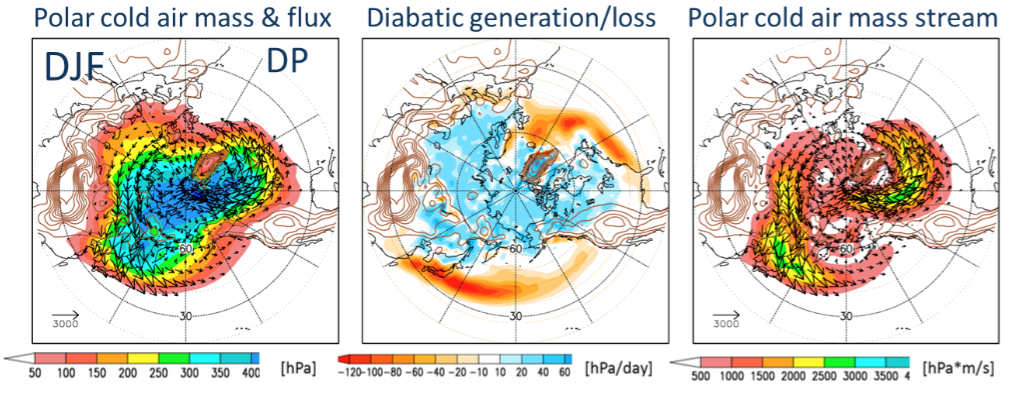
Isentropic analysis of polar cold air mass streams
(polar cold air mass streams defined below a threshold potential temperature of 280K)
Research Subjects
・General circulation of the atmosphere and polar cold air streams in isentropic coordinates
・High-resolution nonhydrostatic numerical model
・Land surface process and atmospheric boundary layer, Glaciology, Hydrology
Overview of Research
We investigate various aspects of meteorology and atmospheric science by using numerical models, diagnosing comprehensive data set and conducting specially coordinated observations. Our research works are to extend basic knowledge on the atmospheric sciences and apply them to improve predictive skill of the weather, climate and environment.
Global meteorology: 1) We are constructing a new theoretical framework of the atmospheric general circulation based on mass-weighted isentropic zonal means for the purpose to express wave-mean-flow interaction. It provides us with a consistent view of meridional transports of angular momentum, heat, and trace constituents in the atmosphere. 2) A diagnostic method is being developed for polar cold air mass streams defined below a threshold potential temperature. The isentropic threshold facilitates a Lagrangian view of the cold air mass streams from diabatic generation to disappearance. In the NH winter, the polar cold air mass flux has two distinct mainstreams, named as the East Asian stream and the North American stream. In particular, the equatorward flows significantly indicate locations of cold air outbreaks, the so-called cold surges. Increasing interests are placed in global warming effects on the polar cold air mass
Meso-scale meteorology: 1) We are developing a downscaling local weather prediction system using high-resolution nonhydrostatic numerical models. It can reproduce local circulations reflecting the complex configuration of mountains and coastlines, which produce wavering upward and downward air movements in synoptic-scale environments. A particular attention is paid to ensemble downscaling techniques to increase the reliability of forecasts. 2) Cloud resolving simulations of tropical cyclones are studied aiming at improvement of their intensity forecasts. 3) Data assimilation technique is being developed with an application to real-time meteorological monitoring and prediction for use in aviation meteorology.
Land surface processes and atmospheric boundary layers: Our task is to investigate the interaction between the atmosphere and the land surface based on observations. The atmospheric boundary layer is crucial to our daily life because it strongly influences weather in our living space and functions as an external force on atmosphere. We wish to understand the exchange of water and energy between the atmosphere and the land surface and seek to establish a physical model describing it. Numerous and varied questions remain related to meteorology, glaciology, hydrology, agriculture, disaster prevention, water resources, and forest science. Our ancillary research subjects include examinations of the effects of change in the land surface on climate, the metamorphism of snow cover, snow and glacier melting, leaf wetness connected with agricultural disease.
Faculty (Researches) (as of September 30, 2015)
Prof. IWASAKI Toshiki
(global numerical modeling and high-resolution nonhydrostatic numerical model)
Assoc. Prof. YAMAZAKI Takeshi
(ground surface processes, glaciology, hydrology, atmospheric boundary layer, modeling)
Assoc. Prof. SHA Weiming
(local circulation and wind, urban climate and weather, cloud and precipitation, numerical geophysical fluid dynamics)
